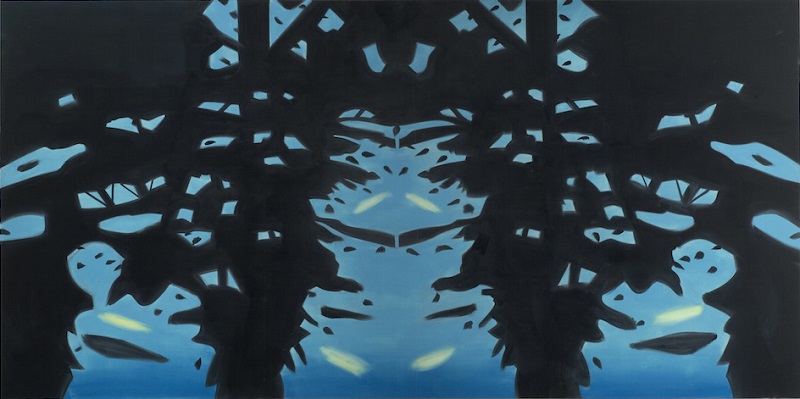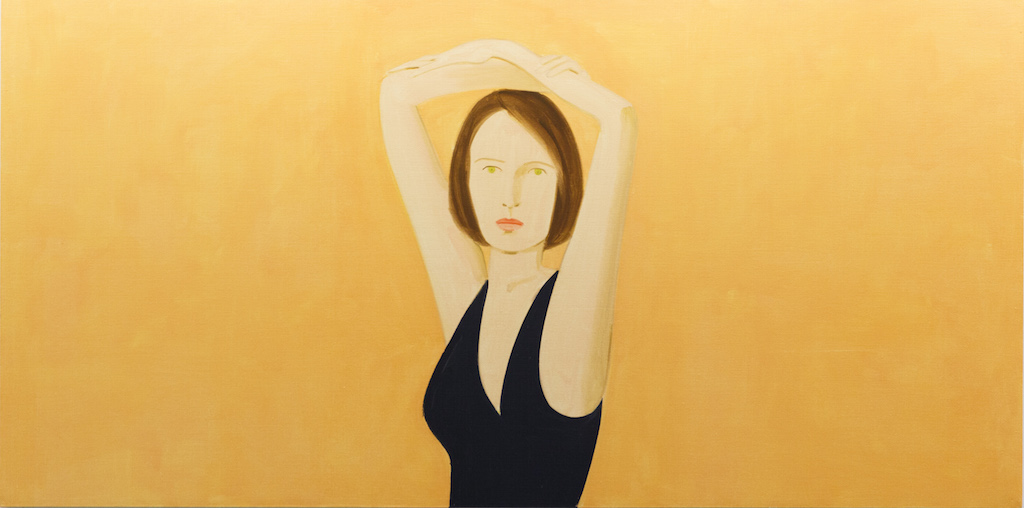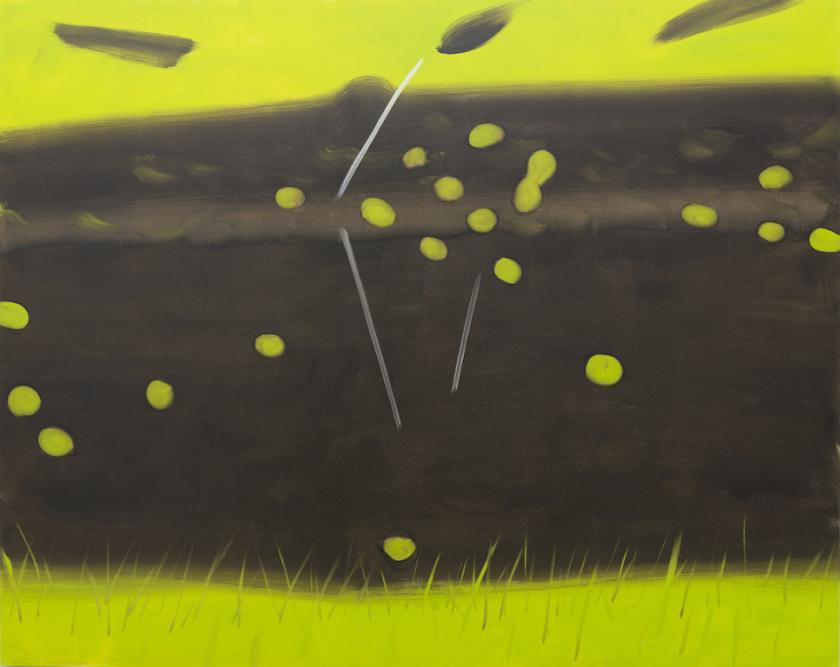Black Brook, 2014, is sublime. Two bands of acid-green grass frame a horizontal band of deep-violet water that appears to have hidden depths. Dotted randomly over the darkness are clusters of light blobs; they could be floating leaves or reflections dancing on the surface. There’s no way of telling.
Hovering midway between the abstract and figurative, the painting is deliberately paradoxical. The language used to create the image is as important, and as visible, as the image itself. This allows the work to occupy parallel universes – that of material fact (paint on canvas) and that of imaginative evocation (dark water bounded by green grass). One is self-evidently flat, the other creates a convincing sense of depth -– a contradiction that is the cause of great delight.
 When Alex Katz’s paintings work, they are deeply satisfying and quite magical. The central space at the Serpentine Gallery is hung with large landscapes. Peering into the rich darkness of Cross Light, 2015, you feel as if you are in the boughs of a tall tree surrounded by the canopy. Dotted over the canvas are dabs of pale green suggestive of light catching the occasional leaf. If you allow yourself to be sucked into the image it feels deep, dark and mysterious; but if you stand back, emotionally and physically, it remains flat and utterly banal.
When Alex Katz’s paintings work, they are deeply satisfying and quite magical. The central space at the Serpentine Gallery is hung with large landscapes. Peering into the rich darkness of Cross Light, 2015, you feel as if you are in the boughs of a tall tree surrounded by the canopy. Dotted over the canvas are dabs of pale green suggestive of light catching the occasional leaf. If you allow yourself to be sucked into the image it feels deep, dark and mysterious; but if you stand back, emotionally and physically, it remains flat and utterly banal.
In City Landscape, 1995 the viewer seems to be hovering like a low-flying owl midway between the ground and the tops of trees, whose dark trunks are barely visible in the gloaming. The edges of the branches are illuminated by pale moonlight; a mist is rising from the ground and visible through the haze as out-of-focus blobs hanging in the sky are the stars. The painting is extremely atmospheric, but it also seems to be an exercise to ascertain how little information one needs to create a sense of place.
Reflection 7, 2008 (pictured above), employs the same devices, but it doesn’t work. Instead of conjuring an expanse of dark water patterned with reflections, this huge picture looks like a Rorschach test – the symmetrical patterns that psychoanalysts invite their clients to interpret. The image has no mystery, no resonance, no apparent depth, nor any beauty.
This is the challenge of Katz’s technique. Paring his images down to the point where there is no leeway for manoeuvre, he risks all. There can be no half measures; either they work or they fail. What he is after is a sense of immediacy, of presence. “If you get it right,” he says, “then you get it in the total present tense. That’s what you’re going for, that’s eternity.”
 The American is most famous for his pared-down portraits – huge heads isolated on uniformly coloured grounds; those on show are on harsh orange grounds, a colour redolent of 1960s interior design. The idea came from the movies, where a head measuring up to 40 feet might peer down at you from the silver screen, but Katz’s heads are as minimal as his landscapes. Light shading creates a sense of solidity, without undermining the flatness of the overall design; eyebrows, eyes, noses and lips are indicated with simple lines and faces are framed in cowl-like drapes.
The American is most famous for his pared-down portraits – huge heads isolated on uniformly coloured grounds; those on show are on harsh orange grounds, a colour redolent of 1960s interior design. The idea came from the movies, where a head measuring up to 40 feet might peer down at you from the silver screen, but Katz’s heads are as minimal as his landscapes. Light shading creates a sense of solidity, without undermining the flatness of the overall design; eyebrows, eyes, noses and lips are indicated with simple lines and faces are framed in cowl-like drapes.
Treading the fine line between naivety and sophistication requires nerves of steel, and when the portraits succeed they are imbued with the same paradoxical magic as Black Brook. But, apart from Christy, 2015 (pictured above left), those on show are dreadful; so are the friezes of figures arranged in lines, like sketches for animated sequences. Katz might have chosen to forfeit good drawing for the sake of greater impact, but if that was his aim, he fails to be convincing. These wooden approximations just look incompetent.
HIs extreme stylisation was arrived at in 1950s New York, in reaction to the emotional outpourings of Abstract Expressionists like Pollock and de Kooning. Katz was inspired by poets like Frank O’Hara, who uses stripped-down language to arrive at lines such as “I am stuck in traffic in a taxicab/ which is typical/ and not just of modern life...” (Song, 1960).
In the 1950s, such self-conscious reductionism might have seemed excitingly radical; since then, though, the cultural landscape has shifted dramatically. We have become so used to seeing women reduced to cyphers, whether in fashion and advertising, or in cartoons and video games, that Katz’s portraits now seem like just another example of the one-dimensional dames that flood the visual field. Rather than vital embodiments of pure presence which he was striving for, they all too readily appear lifeless, dull and flat.









![SEX MONEY RACE RELIGION [2016] by Gilbert and George. Installation shot of Gilbert & George 21ST CENTURY PICTURES Hayward Gallery](/sites/default/files/styles/thumbnail_125_x_125_/public/mastimages/Gilbert%20%26%20George_%2021ST%20CENTURY%20PICTURES.%20SEX%20MONEY%20RACE%20RELIGION%20%5B2016%5D.%20Photo_%20Mark%20Blower.%20Courtesy%20of%20the%20Gilbert%20%26%20George%20and%20the%20Hayward%20Gallery._0.jpg?itok=3oW-Y84i)





Add comment